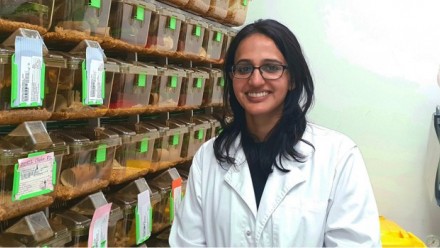Development of biomarkers for the inhibition of SLC6A19 – a potential target to treat metabolic disorders
B0AT1 (SLC6A19) is the major transporter of neutral amino acids at the intestinal epithelia and absorbs the bulk of the diet-derived neutral amino acids from the intestinal lumen. It also reabsorbs neutral amino acids in the renal proximal tubules. Mice lacking B0AT1 show cellular outcomes of protein restriction, such as high FGF21 levels and low mTORC1 activity. Moreover, they have improved glucose homeostasis and resist diet-induced obesity. Pharmacological blockage of this transporter could be used to induce protein restriction and to treat metabolic diseases such as type 2 diabetes and phenylketonuria. A few novel inhibitors of SLC6A19 have recently been identified using in vitro compound screening, but it remains unclear whether these compounds block the transporter in vivo.
My PhD research involved the development of a gas chromatography mass spectrometry (GC-MS) based untargeted metabolomics workflow to find biomarkers specific to inhibition of SLC6A19 in intestine and kidney. We found elevated amino acid levels in urine and faecal samples of SLC6A19ko mice due to inefficient absorption in the intestine and lack of reabsorption in the kidney. By contrast, a few neutral amino acids were reduced in the plasma of male SLC6A19ko mice as compared to other biological samples. Metabolites of bacterial protein fermentation such as p-cresol glucuronide and 3-indole-propionic acid were more abundant in SLC6A19ko mice, indicating protein malabsorption of dietary amino acids. These findings provide putative metabolite biomarkers that can be used to detect protein malabsorption and the inhibition of this transporter in intestine and kidney. With the help of these biomarkers, we also evaluated the efficacy of four different SLC6A19 inhibitors biomarkers in wild type mice. However, none of the selected inhibitors increased the levels of biomarkers to the extent observed in SLC6A19ko mice.
We also investigated the relationship between protein restriction and dietary protein intake in C57Bl6/J wild-type (wt) and SLC6A19ko mice. When SLC6A19ko mice were fed diets containing 5%, 25%, or 52% of their total calories derived from protein, no differences in food intake or weight gain were observed. All essential amino acids significantly positively correlated with increasing dietary casein content in the wt mice. The SLC6A19ko mice showed reduced postprandial levels of essential amino acids in plasma, particularly following high-protein diets. This study also highlights the potential of SLC6A19 as a knock-out or inhibition target to induce protein restriction for the treatment of metabolic disorders.









